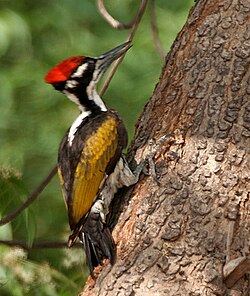Description
The white-naped woodpecker is a large species at 29 cm (11 in) in length. It is a typical woodpecker shape. The white hind neck extends down the back, and the black shoulder patches also continue onto the back to form a V-shape bordering the white. The rest of the upperparts and wings are golden yellow. The rump and tail are black, and the underparts are white with dark chevron markings. The head is whitish with a dark moustache stripe and a black eye patch that extends down the neck sides. The adult male white-naped woodpecker has a red crown and females have a yellow crown. Young birds are colored like the female, but duller. [8]
Like other woodpeckers, this species has a straight pointed bill, a stiff tail to provide support against tree trunks, and zygodactyl or "yoked" feet, with two toes pointing forward, and two backward. The long tongue can dart forward to capture insects. [9]
This page is based on this
Wikipedia article Text is available under the
CC BY-SA 4.0 license; additional terms may apply.
Images, videos and audio are available under their respective licenses.


